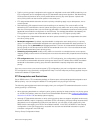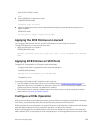
• Traffic in priority groups is assigned to strict-queue or weighted round-robin (WRR) scheduling in an
ETS configuration and is managed using the ETS bandwidth-assignment algorithm. Dell Networking
OS de-queues all frames of strict-priority traffic before servicing any other queues. A queue with
strict-priority traffic can starve other queues in the same port.
• ETS-assigned bandwidth allocation and strict-priority scheduling apply only to data queues, not to
control queues.
• Dell Networking OS supports hierarchical scheduling on an interface. The control traffic on Dell
Networking OS is redirected to control queues as higher priority traffic with strict priority scheduling.
After the control queues drain out, the remaining data traffic is scheduled to queues according to the
bandwidth and scheduler configuration in the DCB map. The available bandwidth calculated by the
ETS algorithm is equal to the link bandwidth after scheduling non-ETS higher-priority traffic.
• The configuration of bandwidth allocation and strict-queue scheduling is not supported at the same
time for a priority group.
• Bandwidth assignment: By default, equal bandwidth is assigned to each dot1p priority in a priority
group. To configure the bandwidth assigned to the port queues associated with dot1p priorities in a
priority group, use the bandwidth percentage parameter. The sum of the bandwidth allocated to all
priority groups in a DCB map must be 100% of the bandwidth on the link. You must allocate at least
1% of the total bandwidth to each priority group.
• Scheduling of priority traffic: dot1p priority traffic on the switch is scheduled to the current queue
mapping. dot1p priorities within the same queue must have the same traffic properties and scheduling
method.
• ETS configuration error: If an error occurs in an ETS configuration, the configuration is ignored and
the scheduler and bandwidth allocation settings are reset to the ETS default value: 100% of available
bandwidth is allocated to priority group 0 and the bandwidth is equally assigned to each dot1p
priority.
If an error occurs when a port receives a peer’s ETS configuration, the port’s configuration resets to the
ETS configuration in the previously configured DCB map. If no DCB map was previously applied, the port
resets to the default ETS parameters.
ETS Prerequisites and Restrictions
On an S6000 switch, ETS is enabled by default on Ethernet ports with equal bandwidth assigned to each
802.1p priority. You can change the default ETS configuration only by using a DCB map.
The following prerequisites and restrictions apply when you configure ETS bandwidth allocation or strict-
priority queuing in a DCB map:
• When allocating bandwidth or configuring strict-priority queuing for dot1p priorities in a priority group
on a DCBx CIN interface, take into account the CIN bandwidth allocation (see Configuring Bandwidth
Allocation for DCBx CIN) and dot1p-queue mapping.
• Although ETS bandwidth allocation or strict-priority queuing does not support weighted random early
detection (WRED), explicit congestion notification (ECN), rate shaping, and rate limiting because these
parameters are not negotiated by DCBx with peer devices, you can apply a QoS output policy with
WRED and/or rate shaping on a DCBx CIN-enabled interface. In this case, the WRED or rate shaping
configuration in the QoS output policy must take into account the bandwidth allocation or queue
scheduler configured in the DCB map.
Priority-Group Configuration Notes
Data Center Bridging (DCB)
253


















